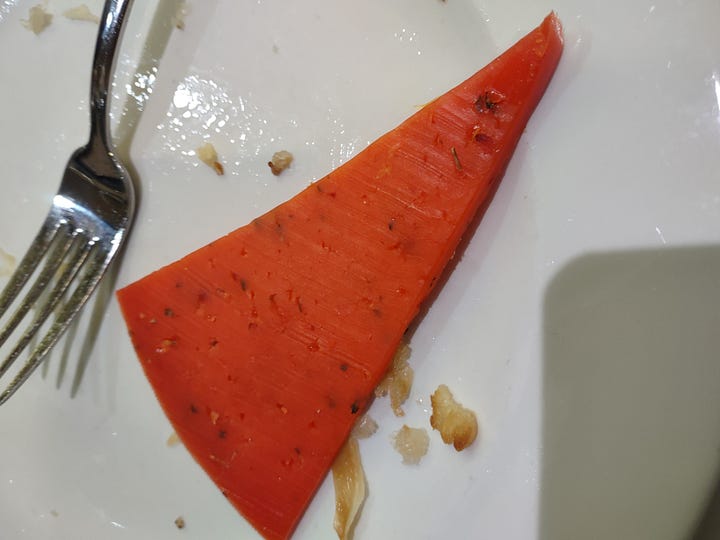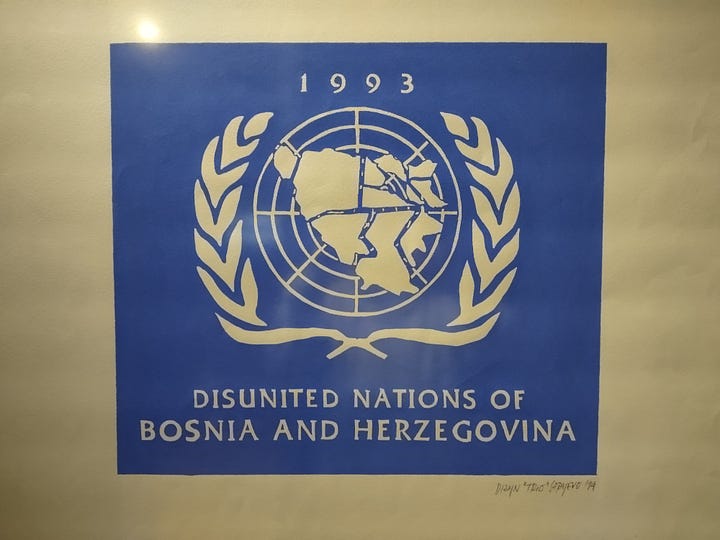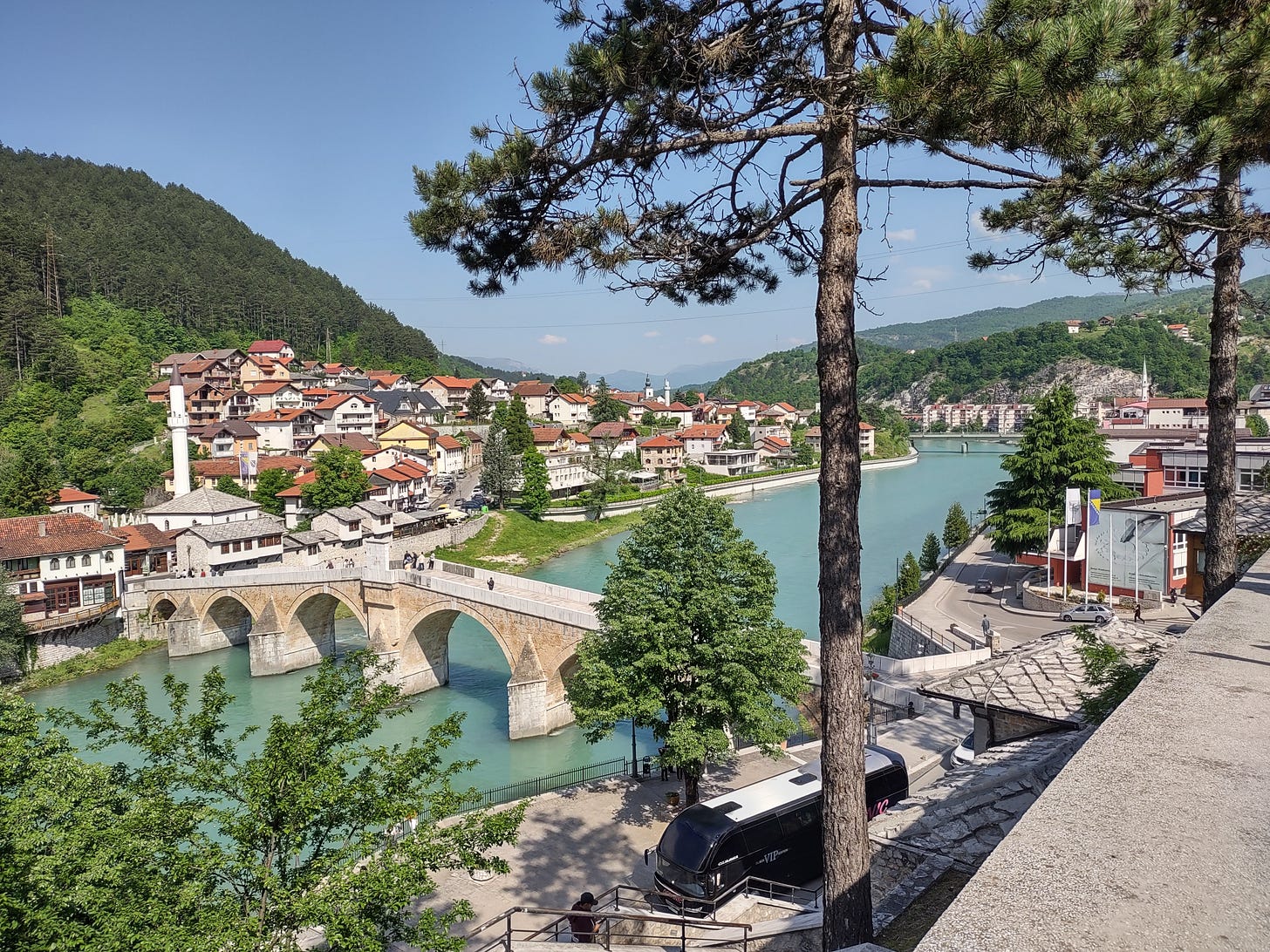Travelling in (the former) Yugoslavia
[Strong trigger warnings for genocide]
[Edited to add links my YouTube videos of the Partisan Memorial Cemetery in Banja Luka, and the Bobsled Track and Hotel Igman in Sarajevo.]
I’ve wanted to visit Bosnia ever since reading Joe Sacco’s Safe Area Goražde and Joe Kubert’s Fax from Sarajevo. I remember being horrified by what happened during the siege of Sarajevo and throughout the Bosnian war, but also amazed by the Bosniaks* survival and depth of humanity. The idea that my friends and neighbours, people I’ve known all my life, could suddenly turn violent and genocidal remains horrifying and yet increasingly plausible. Something between the banality of evil and the realization that groups of people can revel in acts of violence that are horrific even to contemplate.
I will finish this post with a story that I learned that I feel describes this cruelty, while also revealing the ability of individual’s and group’s to stop; however insufficient that may be. Before I do so I will warn you. There are things that you can learn, which you cannot unlearn. Knowledge, perhaps, that is unethical to inflict on others. I tell this story because I believe it is important, but consider for yourself whether you want, or need, to be burdened with it.
I visited Yugoslavia in May 2023 with the intention of both viewing Brutalist architecture, which the region is famous for (and I’ll write a separate post about later), and to better understand the people and their history. During this trip I visited Slovenia, Croatia, and Bosnia and Herzegovina, but I spent the most time in Bosnia. I had intended to visit Serbia and Northern Macedonia as well, but my travelling partner came down with Covid, and so we ended up in Sarajevo for a little over two weeks. This was actually a blessing, as it is a wonderful city, filled with incredible architecture, history, and food.




In fact, Bosnia and Herzegovina is stunningly beautiful and the people are incredible friendly and welcoming, but not in a way that’s overwhelming. I felt, if not comfortable, at home. The pace of life was wonderful and I think it might actually be my favourite place.
I say this up front, because I want people to understand that the country is incredibly alive. It is a place with a living and vibrant culture and you should absolutely visit it immediately.
But there is a darker side to Bosnia. It’s not hidden. It’s all around you. All the time. It’s like the static in the air before a thunderstorm. Like everyone is holding their breath.
The Dayton Agreement*** froze Bosnia and Herzegovina in time without a reasonable expectation of progress. It has made governing and bureaucracy so intrinsically complicated and overlapping that it is all but impossible for the country - and in some cases the regions and cities - to move forward in any way. It rewarded brutality that I find difficult to express with a stalemate that will require international enforcement into the unforeseeable future. And, despite that, it’s hard not to see it as a victory, if a pyrrhic one. Or maybe it’s just better than all the other, worse, alternatives.
The Siege of Sarajevo lasted, between 1992 and 1996, for 1,425 days. It remains the longest siege in modern warfare at about 425 days longer than Leningrad. And during most of this period snipers would shoot civilians wherever they were visible from the surrounding hills. In fact, recent evidence has emerged of Serbian politicians, businessmen, and wealthy foreigners travelling to the hills around Sarajevo for the privilege of paying to kill civilians, including children, during so-called Sarajevo Safaris. It’s said that children cost more. I found myself constantly, if unconsciously, looking around corners and considering whether I might be visible to the mountains while there.




These are pictures of Sarajevo Roses. They mark the places where a bomb landed and killed at least - but often much more than - 5 people****. The top right and bottom left mark the Bread queue massacre**, where 26 people were murdered. There are at least 200 roses throughout the city. They’re everywhere. I found that I learned to identify unmarked ones where I would have assumed before that the pavement was simply cracked or worn.
The Sarajevo rose on the bottom right commemorates the Markale massacres and, if you look closely, you can see the remains of the projectile. Whether the original or a recreation I can’t say. The Markale market was, and still is, a vegetable market in Sarajevo. I bought some very good fruit and veggies from some very nice people there. During the siege it was a place where people could meet, sell goods, or simply visit with their neighbours and try to find some kind of normality. It was a dangerous place to visit in the sense that it was dangerous to go anywhere; but, it was also surrounded by buildings that covered sight lines to the mountains and so comparatively safe.
On Feb 5, 1994, the Army of the Republika Srpska launched a mortar targeted at the Markale market. It killed 68 people and wounded 144 more. On Aug 28, 1995 they launched 5 more that killed 43 and wounded 75. The count was only less because fewer people visited after the first attack. The Army of the Republika Srpska blamed - and many still do despite all evidence to the contrary - that Bosnian forces had bombed the market to elicit international sympathy and NATO intervention. Admittedly, there does seem to be some quibbling about responsibility for the first attack, but the evidence that it was an inside job, so to speak, seems rather thin and ultimately unconvincing.
And consider this picture.
Maybe you don’t see it. That’s okay. I wouldn’t have. But look more closely. Zoom in and you'll see it. The unmistakable sun shaped curve of a blast impact on the bottom of the pink building. Zoom in closer on the top of the white one to the right and you'll see the splatter arc of the shrapnel.
Sarajevans will tell you that these were kept as reminders of the literal and figurative impact of the siege. And that's true, as far as it goes. But it's also the case that Bosnia and Herzegovina are too poor, and the damage too extensive, to fix all or even most of it. So they remain as ghostly reminders of an unimaginably vicious near past. To be seen by victims who can't escape and perpetrators who won't admit.
But this is also a story of heroism. It is a story of every Bosnian and Sarajevan, and I mean this now in the present sense, giving whatever they could for collective survival. The following images, for instance, are from the Design Trio Sarajevo, which undertook to use postmodernist graphic design to garner international support, or at least awareness, of Sarajevan’s elemental fight for survival.





There were certainly armed defenders that took up the struggle within the city and in the hills, but there were also artists, musicians, and tunnel builders that did everything in and beyond their power to bring the attention of a reluctant world to the ongoing genocide. Even if, or maybe especially because, it felt hopeless. This even took on a decidedly surrealist bent, including the creation of a Beauty Pageant that was held underground and called Miss Besieged Sarajevo.
The women in the picture strike me as surreally ecstatic and I wonder if their smiles were intentionally juxtapositioned with the reality or the banner, or if they were simply enjoying a brief emotional reprieve from the siege.
And there are these souvenirs gifted from Arnold Schwarzenegger to Dzemel Hodzic, the son of Fikret Hodzic, a championship Yugoslavian bodybuilder and colleague murdered by Serb paramilitaries. That’s an interesting thing about the Museum of Genocide and Crimes Against Humanity. It seems to serve as a repository for the collected memories and wartime ephemera that have been saved by the survivors.





Schwarzenegger’s letter oddly encapsulates the Bosnian need to ‘put the tragedy behind them’ confronted by the impossibility of doing so. Rather than seeing it as a blithe response to a terrible tragedy, as I might have, it seems to show the difficulty of grappling with responding to something so inconceivable, but trying anyway.
But look. I could go on forever telling stories about what happened and how I don’t understand it. Perhaps that’s the point. No rationale person could. Ultimately I can’t find the words, except to express that somewhere, something went seriously wrong. And then it kept going wrong.
.
.
.
And so now I’ll leave you with that story I told you about. The one I warned you about. And I really think now that you should skip it, though I’m going to keep going because I think it’s representative of everything else.
So here’s the story, as told by the Republic of Srpska solider that witnessed it. Mr protected witness 101.
The boy was 7 when he was executed at Srebrenica. Our soldier describes the horror of the massacre. Of seeing piles of bodies of executed people. And it feels a little self-pitying because, after all, he was participating in it. But now he’s describing how something moved in one of the piles. Of how a little boy emerged “from the pile of stacked corpses… a human being.” And how the boy walks straight towards the soldiers who, “trained to kill” are nonetheless paralyzed and drop their weapons. A colonel tells them “what are you waiting for? Finish him” and instead of doing so they say “Sir, you have a gun too, why don’t you finish him?”
This isn’t heroism, to be sure, but it is a pause in the insanity. A realization that maybe the colonel is telling them to do something that he could never do himself. That he cares about as much for them as a man would about a bullet in his gun. So the colonel, perhaps sensing the limit of his powers and his own stomach, orders them to put the child on a truck to be executed by the next group. And our solider intervenes. He tells the colonel that he will calm the child down. That he will take care of it and “play music to distract him.” I don’t think, reading this 30 years later, that protected witness 101 knew what we was going to do. He was just reacting in the moment with something less than blood lust. In a moment of pause.
So our soldier distracted the boy with music and the lights in his car. And he drove him to the hospital in Zvornik. And, when he handed him over, the boy grabbed him and said “baba (dad), do not let them take me, please.” And the boy lived to be the only survivor of the Srebrenica massacre from his village and, until few years ago, he was forbidden to reveal his identity. And our solider, well, he “was extremely shocked by the whole event.” And isn’t that just perfect because, if ever there was an underwhelming final line, this is it.
But still, there’s something there. That moment of, if not humanity, of pause. Of saying, I don’t have to do this thing. Not yet. Maybe it won’t save our soldiers’ soul, and maybe that’s not the point. Maybe it’s just, for one moment, opting to not do one single bad thing after so, so many others. And I guess that’s something do me, because I’m very grateful that at least the boy survived, though I hope the soldier, our soldier, rots in The Hague.
Footnotes
*I use this word in the sense it’s given now. My understanding from speaking with folks is that during the Yugoslav period it referred to all citizens of Bosnia and Herzegovina, regardless of ethnicity or religion. Please correct me if this is wrong.
**Some references cite the Markale massacre as being called the Bread queue massacre, but I haven’t come across that in any other sources, so I have the one that references this site and plaque specifically.
***I have cited Wikipedia in several instances where the general knowledge is known (e.g. what is a Sarajevo rose). I also provide additional citations throughout.
****There is a discrepancy here. The Wikipedia article states 3, but the individual I spoke with, who was in the Bosnian army stated 5. I have deferred to his expertise, as someone who survived the siege.
References and Further Reading
Balkan Investigative Reporting Network. (2010, May 11). Karadzic claims of ‘staged Markale massacre’. Balkan Transitional Justie. https://balkaninsight.com/2010/05/11/karadzic-claims-of-staged-markale-massacre
Binder, D. (1994). Anatomy of a massacre. Foreign Policy. https://www.jstor.org/stable/1149440.
Brockett, D. (2019). I want to write my own future. Homeless World Cup. https://www.homelessworldcup.org/stories/i-want-to-write-my-own-future
Cantonal Institute for the Protection of Cultural, Historical and Natural Heritage of Sarajevo. (2012, Nov). Sarajevo, memorial plaque to citizens killed int he bread queue massacre. Kultura Sjećanja. https://kulturasjecanja.org/en/sarajevo-memorial-plaque-to-citizens-killed-in-the-bread-queue-massacre/
Dayton agreement. (n.d.). In Wikipedia. https://en.wikipedia.org/wiki/Dayton_Agreement
Devesdesete. (2018). Sarajevo’s War Surrealists. Learning history that is not yet history. https://devedesete.net/sarajevos-war-surrealists/
International Criminal Tribunal for the FormerYugoslavia. (2009, Nov 2). Karadzic statement. https://www.icty.org/x/cases/karadzic/trans/en/091102IT.htm
Kubert, Joe. Fax from Sarajevo. Dark Horse Comics.
Markale Massacres. (n.d.). In Wikipedia. https://en.wikipedia.org/wiki/Markale_massacres
Meet Bosnia. (2023). Sarajevo war tunnel. https://meetbosnia.com/sarajevo-war-tunnel/
Museum in Exile. (n.d.). Bojan Hadžihalilović. http://museuminexile.com/index.php/designers/bojan-hadzihalilovic-trio
Niebyl, D. (n.d.). Spomenik database. https://www.spomenikdatabase.org/
Sacco, Joe. (2000) Safe Zone Goražde. Fantagraphics.
Sacco, Joe. (2003). The Fixer. Drawn and Quarterly.
Sarajevo Rose. (n.d.). In Wikpedia. https://en.wikipedia.org/wiki/Sarajevo_Rose
Siege of Sarajevo. (n.d.). In Wikpedia. https://en.wikipedia.org/wiki/Siege_of_Sarajevo
Synovitz, R. (2016, Sep 29). Whitewashing war crimes? Bosnian Servs to ‘reconstruct’ Sarajevo market shellings. RadioFreeEurope RadioLiberty. https://www.rferl.org/a/bosnia-serbs-reconstruct-1994-sarajevo-market-shellings/28022648.html
Zulić, A. (2020., May 12). Miss besieged Sarajevo: Fashion and beauty as symbols of resistance. Balkan Diskurs. https://balkandiskurs.com/en/2020/05/12/miss-besieged-sarajevo/
(Zupanič, M.). (2022). Sarajevo Safari [Film]. Cankarjev Dom. https://www.cd-cc.si/en/culture/cinema/sarajevo-safari






